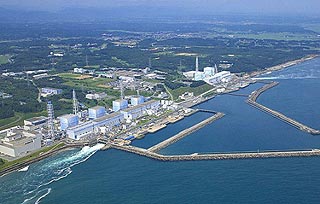【译注】这是一篇[爪译]的翻译文章,原文来自2011-3-13《MedPageToday》的 Katie Moisse, ABC News Medical Unit,点这里查看英文原文Reactor Disaster Poses Health Risks.以下为中英对照译文。
 </p>
</p>
日本官方于上周日称有四所核电站在3月11日的地震中受到影响,但截至目前,他们仅宣布其中两所——福岛一厂(Fukushima Daiichi)和福岛二厂(Fukushima Daini)进入紧急状态。以下报道来自MedPage今天的新闻搭档——ABC新闻医疗版,为您更新以上消息。
Japanese officials said Sunday that four nuclear power plants have been affected by the earthquake on March 11, but thus far they have declared an emergency at only two of those plants — Fukushima Daiichi Nuclear Power Station and the Fukushima Daini Nuclear Power Station. The following report from MedPage Today’s news partner, ABC News Medical Unit, was prepared prior to that update.
自周五那场8.9级地震发生后,日本福岛核电厂爆发出巨大的蒸汽柱并向四周漂散,随时存在崩塌危险。美国科学家提出警告说,这可能会造成严重的健康隐患。
The steam plume drifting from the Fukushima, Japan, nuclear plant that exploded after Friday’s 8.9-magnitude earthquake and the looming possibility of a meltdown there have U.S. scientists warning of possible serious health risks.
据日本官员称,尽管保护核电厂一号反应堆的钢制容器在爆炸中并未遭到重创,核电厂附近的辐射水平已经上升了大约两倍,达到警戒程度,促使电厂周围的疏散半径翻倍扩大至20公里。
Although the steel container protecting the plant’s No.1 reactor was not damaged in the explosion, radiation levels near the plant rose to roughly twice that which constitute an emergency situation, according to Japanese officials, prompting a doubling of the evacuation radius to 20 kilometers.
后来日本核安全局宣布,同一核电厂二号反应堆的冷却系统发生故障。
Japan’s nuclear safety agency has since reported a malfunctioning cooling system at a second reactor in the same plant.
这种情形让人不由得想起1986年的切尔诺贝利灾难和1979年靠近美国宾夕法尼亚州哈里斯堡的三里岛事故。
The scene evokes memories of the Chernobyl disaster of 1986 and the Three Mile Island accident near Harrisburg, Pa., in 1979.
三里岛核能生产站的部分崩塌结束了美国当年如火如荼的核能建设,这次事故并没有和死亡、癌症相关联。但切尔诺贝利核电站爆炸后的辐射照射,直接导致了超过50例死亡,可疑相关的死亡还有更多。
The partial meltdown at the Three Mile Island Nuclear Generating Station, which ended nuclear power construction in the U.S., has never been linked to deaths or cancer. But radiation exposure following the Chernobyl meltdown was directly implicated in more than 50 deaths and suspected in many more.
“切尔诺贝利事故已经过去25年了,至今还没人对这个问题做出结论性的评估。”亚利桑那大学的核能与能量工程教授John Williams如是说。
“No one has yet conclusively assessed this question 25 years after the Chernobyl accident,” said John Williams, professor of nuclear and energy engineering at the University of Arizona.
可接受的辐照水平是每年10微西弗(mSV),这一数据基于一个“无阈值”模型,该模型假定辐射剂量和癌症风险间存在直接关联,并暗示所有超过自然水平的都是有害的。但一些专家认为,按单位计算,低水平的辐射危害可能没那么大。
The acceptable level of radiation exposure, up to 10 microsieverts per year, is based on a “no threshold” model, which assumes a direct relationship between radiation dose and cancer risk and implies anything beyond natural levels is harmful. But some experts argue that low-level radiation may be less harmful on a per unit basis.
Jacky Williams是罗切斯特大学医学中心放射后生物物理评估和风险处理中心的主任及首席领导人。他称这20公里的撤离半径是“躲开放射性沉降物极端保守的安全区域”。
Jacky Williams, director and core leader of the Center for Biophysical Assessment and Risk Management Following Irradiation at the University of Rochester Medical Center, called the 20-kilometer evacuation radius an “extremely conservative safety zone to protect against fallout.”
Williams说,广岛和长崎轰炸后的辐射剂量从原子弹着地点往外每200米就衰减一半。
The radiation dose following the Hiroshima and Nagasaki bombings was cut in half every 200 meters from ground zero, Williams said.
但是福岛核电厂爆炸产生的沉降物可以发生多种情况,这很大程度上取决于泄漏产气的方式——是通过像切尔诺贝利那样一次性中央的爆破产生,还是通过缓慢、可控的压力释放出来,风向也是重要影响因素。
But the fallout from a Fukushima could vary greatly depending on the nature of any leak — whether it’s through an explosion of the core, as in Chernobyl, or a slow, controlled release of pressure — building gases — and the wind.
“只要不在下风向上,20公里外的民众是不会面临即刻的危险的。”Williams说。
“Members of the public are not in imminent danger at a distance of 20 kilometers, so long as they are not downwind,” Williams said.
不过,虽然撤离区的幅度可以限制急性放射疾病发生的风险,但造成慢性病如癌症和心血管病的可能依然存在。
But while the breadth of the evacuation zone may limit the risk of acute radiation sickness, the potential for chronic conditions, such as cancer and cardiovascular disease remains.
忧思科学家联盟的资深科学家Edwin Lyman指出,福岛辖区内的风可以将100英里以外的辐射强度推进到能造成癌症的水平。居住着将近1300万人的东京大约在200英里之外。
Edwin Lyman, a senior scientist with the Union of Concerned Scientists, said wind over the Fukushima prefecture could boost radiation to cancer-causing levels up to 100 miles away. Tokyo, home to nearly 13 million people in 2009, is roughly 200 miles away.
切尔诺贝利爆炸产生的烟雾漂散至欧洲的大部分地区和苏联,使三十万人被迫撤离。
The plume from the Chernobyl explosion drifted over large parts of Europe and the Soviet Union, prompting the evacuation of more than 300,000 people.
据国家研究委员会称,低剂量的辐照还与心血管疾病风险升高相关。
Low dose radiation exposure is also linked to a heightened risk of cardiovascular disease, according to the National Research Council.
据报道,头戴面罩、身穿防护服的工人们正手拿扫描器,在这个1200多平方公里区域边界上的撤离中心筛查福岛的疏散人员。
Workers clad in masks and protective clothing are reportedly screening Fukushima evacuees with handheld scanners at evacuation centers bordering the more than 1,200-square kilometer zone.
Williams说,这些防护措施以及保证食物和水供不受污染,对未来几天、几周非常关键。
Such protections, as well as ensuring the food and water supply stays uncontaminated, will be crucial in the days and weeks to come, Williams said.
分发碘化钾是另一项重要的预防措施,因为核电站爆炸会向空气中释放放射性碘元素。(这一措施主要保护甲状腺,甲状腺是人体主要的摄碘器官,甲状腺素合成以碘为原料,大量放射性碘元素被甲状腺摄取后会造成危害,服用碘化钾的作用在于使甲状腺预先被普通碘饱和,可以减少它对放射性碘的摄取——译者按)
The distribution of potassium iodine is another important precaution, as a meltdown could release radioactive iodine into the air.
自切尔诺贝利事件发生后,向孩子们发放碘,已经成为存在高辐射泄漏风险时的标准应对措施。
Since Chernobyl, distributing iodine to children has been a standard response when risk of radiation release is high.
